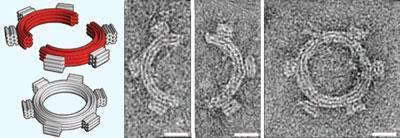Gaining fine control over DNA structure could lead the way to tiny tools and devices
US scientists have demonstrated a nanoconstruction approach that allows the creation of self-assembling DNA ’origami’ folded in an array of different shapes, from bent rods to toothed gears. The researchers say their work opens up new possibilities for engineering nanoscale tools and devices.
In nature, DNA adopts many different forms but gaining precise control over its shape in synthetic systems has proved challenging. The new study, led by Hendrik Dietz, now at Technische Universit?t M?nchen in Germany, shows that targeted changes to the base code can be used to finely tune the twist and curvature of a bundle of DNA helices.
Importantly, says co-author William Shih of Harvard University, the advance allows scientists to produce continuously curved structures as opposed to kinked structures. ’I think, with a little bit of imagination, having control over curvature is actually a fundamental advance in nanofabrication capability,’ he says. ’Imagine if you had a world where you could only build with straight elements - you would not be able to make a wheel. A more subtle point is that it’s very challenging to maintain rigidity over a kink, which is often a weak point.’
The team’s strategy is based on DNA bundles being divided into blocks of regular lengths by crosslinks between the helices - ’staples’. The staples constrain the shape of the bundles so that systematically inserting or deleting bases causes the DNA to twist and bend. As Shih explains, the net effect of adding or removing material is expanding or contracting, the result being that the whole structure bends to accommodate the change.

According to Paul Rothemund, who studies DNA nanostructures at the California Institute of Technology, the approach is so unexpectedly simple that it could have been worked out in a high school maths class. ’I thought that it would be several years before we reached the mastery achieved here and that it might require some serious computer modelling,’ he says. ’I think it can now truly be said that we can make any shape that we desire out of DNA.’
Shih believes that gaining precise control over the structure of DNA will lead to major steps forward in the development of custom instruments for biology and biophysics. ’We’re designing tools on the nanoscale and an advantage of that is you can use self-assembly and make lots of them, whereas with optical traps or atomic force microscopy you’re basically stuck with one at a time,’ he says.
Hao Yan, a bio-nanotechnology specialist at Arizona State University, says the level of quantitative control over twisting and bending is impressive. He thinks Shih’s work could serve as a standard for creating new types of mechanical DNA and proteins.
Hayley Birch
Interesting? Spread the word using the ’tools’ menu on the left.
References
H Dietz et al, Science, 2009, 325, 725, DOI: 10.1126/science.1174251






No comments yet